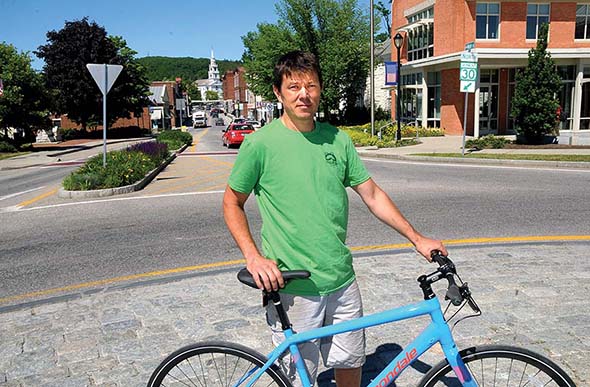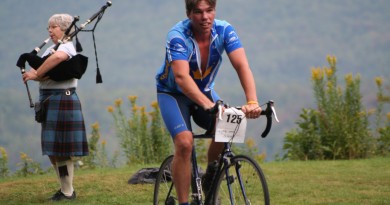Just How Bike Friendly Are Vermont Cities?
A recent evaluation by biking advocacy group PeopleForBikes says Middlebury, Burlington, Rutland and other cities’ infrastructure leave something to be desired.
By James Finn
MIDDLEBURY — A recent survey evaluating accessibility, safety and enjoyability of biking in cities and towns across the United States made clear that Middlebury’s cycling infrastructure leaves something to be desired.
The PlacesForBikes City Ratings survey, a two-year, data-driven project conducted by the biking advocacy organization PeopleForBikes, awarded each surveyed location an overall score meant to provide a snapshot of the quality of cycling life in cities and towns across the U.S.
That Middlebury received an overall score of just 1.4 out of 5 possible points came as no surprise to members of the local cycling community.
“I think the general mentality around bikes here is dated,” said Andrew Gardner, a local cyclist whose advertising agency, Press Forward, manages public relations for PeopleForBikes. “When you look at the questions that are being asked independent of [cycling], such as how do we retain young people, how do we make our downtown vibrant, they’re being asked over here in one box, and bikes are over here in this other box. To me, those things are really related and cycling can be a part of that process.”
Other Vermont towns featured in the PeopleForBikes survey didn’t fare much better than Middlebury. Burlington slightly outpaced Middlebury with an overall score of 2.1, Montpelier and Rutland each earned 1.5, and Brattleboro took home a 0.9. The highest-scoring cities on the survey were Fort Collins and Boulder, Colo., and Wausau, Wis. — all of which earned overall scores of 3.5. PlacesForBikes rated 484 of towns and cities.
In the survey, each location’s “overall score” was derived from sub-scores awarded within five categories:
- Ridership: how many and how often people ride bikes.
- Safety: number of injuries and fatalities from vehicular crashes with cyclists.
- Network: connection to destinations and comfortability with routes.
- Reach: how consistently biking networks serve whole communities.
- Acceleration: how quickly community biking infrastructure is growing.
Middlebury scored just one out of five for ridership, 1.4 for rider safety and 1.6 for network. Its highest score came in the reach category, where it received a 3.2. Insufficient data was obtained to award Middlebury an acceleration score.
Fresh improvements to Middlebury’s biking infrastructure have been in demand for years.
“I would like to see improved infrastructure for kids to ride to school, parents to ride to the grocery store,” Gardner said. “That’s pretty hard to do here. Connecting neighborhoods and schools with accessible paths is the first way to approach that.”
Middlebury’s low rider safety score highlights the mess of safety hazards that bikers must face each time they ride in town: Gardner and other cyclists pointed to disconnected sidewalks, narrow shoulders, recessed grates and dangerous intersections as faulty infrastructure that causes the most headaches.
According to Adam Franco, the chair of the Addison County Walk-Bike Council Chair, Court Street and Washington Street Extension before it becomes Painter Road are just two examples of many areas in which infrastructure gaps are particularly glaring.
On Court Street, the array of recessed grates and a narrow shoulder with no semblance of a dedicated bike lane in sight create headaches for bikers trying to traverse between downtown and the south side of town.
“Court Street is a major link between the village downtown and the middle school, Hannaford’s, south village, all of those areas,” Franco said. “While it is possible for people to bypass that area through other routes, it can be quite out of the way and Court Street certainly needs a lot of improvement.”
Going forward, Gardner hopes for an increase in the number of dedicated bike lanes, availability of visible and convenient bike parking, and increased bike signage around Middlebury. He would also like to see a bike-share program and increases in bike-related events such as kids’ safety checks, helmet giveaways and workshops.
But initiating improvements such as shared paths has been a challenge, often due to lack of shoulder space on New England roads. On Court Street, the consistently narrow shoulder and a high number of recessed grates mean that installing a bike path will be all but impossible until the state repaves Route 7 (including Court Street) in 2020, according to Laura Asermily, a member of the Middlebury selectboard and Walk-Bike Council.
The Walk-Bike Council is working to ensure that when the road is repaved, a wider shoulder, potentially with a designated bike lane, will be put in place. Until then, the council and Middlebury Safe Routes, a local branch of the national Safe Routes to School project founded by Asermily that helps educate children about how to safely walk and bike to school, have encouraged riders to take bypass routes when crossing town.
AREAS OF PROGRESS
In Franco’s words, though, it’s not all “gloom and doom” in the Middlebury biking world. Although it will take several more years to complete, a plan is underway to install a shared-use path along Exchange Street in Middlebury’s industrial park. And the Walk-Bike Council is working with the New Haven selectboard on a multi-year project to widen shoulders on River Road, a popular connector for cyclists traveling between Middlebury and Bristol, both near Lincoln Winery and the road’s opposite end where it meets Route 116. And Asermily hopes to soon offer bike parking in locations around town such as commercial shopping centers.
Groups such as the Addison County Bike Club have worked to create a robust mountain biking community that has benefited the town in more ways than one.
“The mountain biking community is so valuable, first because it’s bringing tourists to the area,” Asermily said. “And second, they maintain the trail network not just for themselves, but for hikers and walkers too.”
Carl Robinson, co-owner of Frog Hollow Bikes and vice president of Addison County Bike Club, said that community education can help improve cyclists’ quality of life.
“You have to take road tests to learn how to drive, and maybe part of that should be how to ride a bike on the road as well,” Robinson said. “If you are aware of what it feels like to ride you will be more cognizant of bikers.”
Robinson pointed to biking education initiatives for kids conducted by Middlebury Safe Routes, such as the 6th Grade Practice Bike Ride on June 6, as particularly helpful.
Ultimately, cyclists like Gardner, Asermily and Robinson believe that biking has the power to improve community from the ground up.
“I think getting people on bikes kind of slows everyone down,” Robinson said. “There are more conversations with people as they get to different areas on bikes.”
Gardner points to all of the economic benefits that cycling can have on a place like Middlebury: biking benefits tourism industries reduces costs of automobile and oil dependency and can help minimize costs associated with obesity and physical inactivity.
“It’s not a playground,” he said. “There’s a real socioeconomic utility to biking that’s often overlooked.”
This story originally appeared in The Addison Independent on June 25, 2018.
Photo by Trent Campbell


